

There’s something truly special about welcoming students like Riona to my home in Dosrius. As a British clinical psychologist with a deep love for Spanish and Latin American culture, Riona came to SHIP Barcelona not just to improve her Spanish, but to live it.
With her curiosity, warmth, and adventurous spirit, she embraced each moment of her immersion experience, from practicing conversation over breakfast to exploring the lush natural surroundings just beyond the city of Barcelona, all with the goal of preparing for future travels and deeper cultural understanding in a Spanish-speaking country.
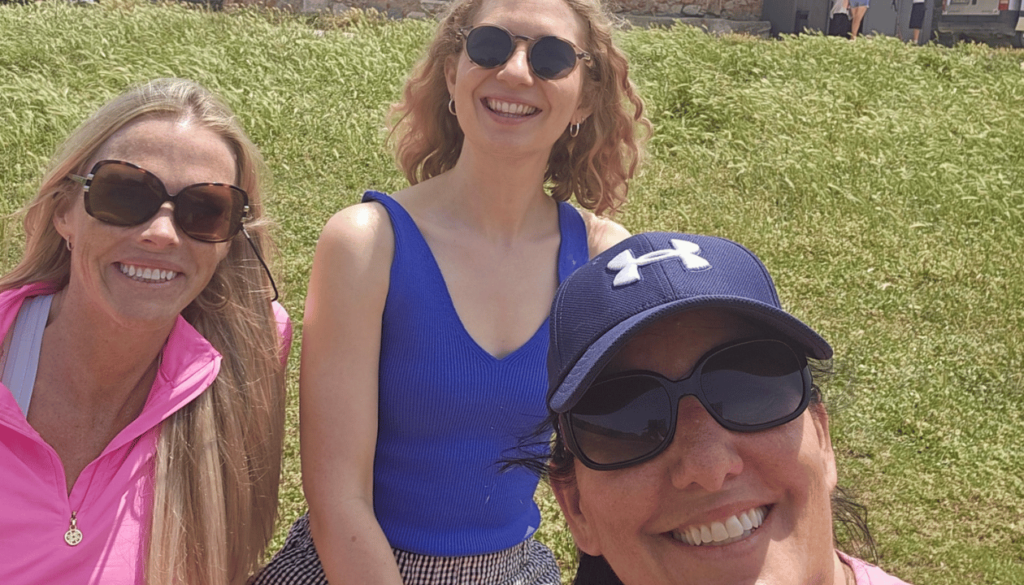
From London to Dosrius: A Change of Rhythm
When Riona arrived in Dosrius, she brought with her the calm presence of a clinical psychologist and the vibrant curiosity of a lifelong learner. Swapping the buzz of London for the peaceful hills just outside Barcelona, she embraced the slower rhythm of village life with open arms.
It was her first time staying outside of the city, and she was excited to see a different side of Catalonia—one that blended local traditions, Mediterranean landscapes, and the daily soundtrack of birdsong and soft mountain breeze. For Riona, this change of setting was the perfect backdrop for a truly immersive learning experience.
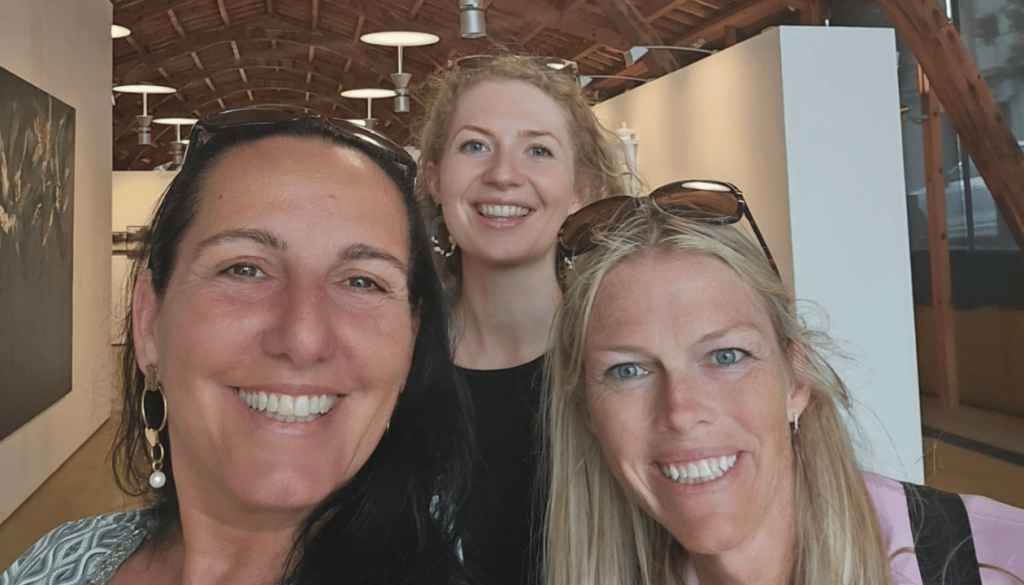
The Power of Language and Connection
From the beginning, Riona made it clear that her goal wasn’t just to “study Spanish”, she wanted to speak it, feel it, and use it to connect. Her dream is to become conversationally fluent, especially for her future travels to Spanish-speaking countries.
We talked often about how much richer travel becomes when you can chat with a waiter, ask locals for recommendations, or simply share a laugh with someone in their native language. Each day during her immersion, she took one step closer to that goal, asking thoughtful questions, listening intently, and using new vocabulary with growing confidence.
Riona understood that making mistakes is a natural and valuable part of the language learning process, and she embraced her mistakes as opportunities for growth.

Language Learning Strategies: How Riona Made Spanish Stick
Riona’s approach to learning Spanish was all about weaving the language into her everyday life. Rather than relying solely on textbooks, she made a conscious effort to incorporate Spanish into her daily routine, turning ordinary moments into opportunities for language learning.
She focused on picking up common verbs and phrases that she could use in everyday conversations, making her practice feel relevant and practical. Whether she was chatting with native speakers over breakfast, listening to Spanish music while out for a walk, or catching up on her favorite TV shows with Spanish subtitles, Riona found ways to immerse herself in the language throughout the day.
To keep her progress on track, Riona also turned to language learning apps and websites, using them to reinforce new vocabulary and grammar points she encountered in real life. She made it a point to practice speaking and listening as much as possible, often repeating new words and phrases aloud to improve her pronunciation and confidence. By focusing on everyday language and making Spanish a natural part of her daily routine, Riona was able to make steady progress and truly learn Spanish in a way that felt both meaningful and sustainable.
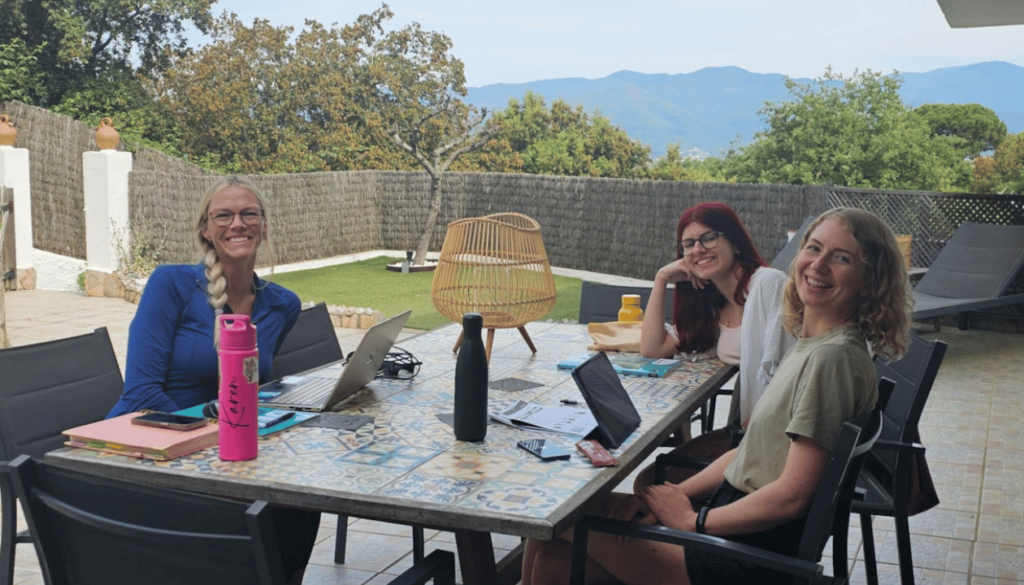
Spanish, Yoga, and the Mindful Life
As someone who practices yoga and cycles regularly, Riona brought a wonderfully grounded energy to her stay. Her calm, reflective nature made her a natural language learner—curious, patient, and deeply observant.
Our conversations often flowed from grammar to life itself, touching on the importance of balance, presence, and well-being. Learning Spanish with Riona felt more like a shared exchange than a lesson, as we connected not only through the language but through a shared appreciation for a mindful, intentional life.
Salsa Steps and Spanish Songs
Music runs through Riona’s life—she plays the guitar, attends live concerts in London, and once danced salsa regularly. Although she hasn’t danced in a while, her love for Latin rhythms is very much alive. During her stay, we talked about the meanings of Spanish lyrics, danced a little in the kitchen while making dinner, and even considered finding a local salsa night.
Singing in Spanish helped Riona improve her pronunciation and expand her vocabulary, as she often enjoyed singing along to Spanish music to reinforce her language skills. Her passion for music made her Spanish learning especially vibrant, as we explored how language lives through sound, feeling, and expression.

A Reader’s Curiosity: Culture Through Books and Museums
Riona is a true book lover—fiction, non-fiction, you name it. Her questions during our lessons often stemmed from ideas sparked by books she’d read or topics she wanted to explore further. She also used a website to find Spanish reading materials and improve her comprehension.
This curiosity made for rich conversations about Spanish society, Latin American history, and cultural nuances. She also expressed a keen interest in visiting museums and soaking up as much local culture as possible, often saying how language learning isn’t complete without diving into the stories that shape a people.
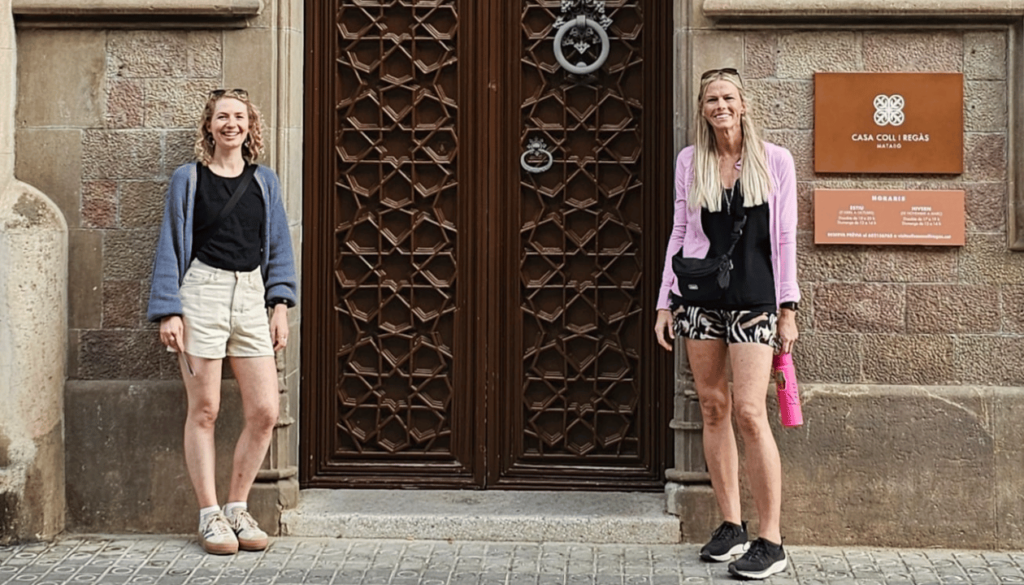
Meals, Markets, and Mediterranean Moments
One of the most beautiful parts of the immersion experience is how much you learn between lessons—over breakfast, during a walk through the village, or while enjoying a homemade meal at casa. Riona loved exploring Spanish cuisine and always asked questions about ingredients, traditions, and local customs.
We spoke Spanish while preparing food at casa, visiting the market, and during meals, turning each moment into a small but meaningful lesson. As part of our Spanish practice, we often discussed what we typically eat for breakfast, lunch, or dinner, and Riona practiced using the verb ‘comer’ to talk about eating meals. Her joy in discovering new tastes and cultural habits made each day feel like a shared adventure.
Overcoming Challenges: When the Rhythm Faltered
Of course, Riona’s journey to learning Spanish wasn’t without its bumps in the road. There were moments when grammar rules seemed confusing, or when her pronunciation didn’t quite match what she heard from native speakers. Reflexive verbs, in particular, presented a challenge—those tricky “me levanto” and “me llamo” forms that are so common in Spanish daily routines. But Riona didn’t let these obstacles slow her down. Instead, she tackled them head-on by focusing on the areas that needed the most attention.
She dedicated extra time to practicing reflexive verbs, using them in sentences about her daily life—“me cepillo los dientes” (I brush my teeth), “me voy al trabajo” (I go to work)—until they became second nature. Writing in Spanish also became a key part of her strategy, helping her internalize grammar rules and expand her vocabulary.
Riona sought out conversation practice with native speakers, joining language exchanges and working with tutors to get real-time feedback and support. By staying focused on her goals and embracing each challenge as a learning opportunity, Riona continued to make progress and build her confidence in Spanish.
A New Friendship: Riona & Karen’s Shared Journey
During her SHIP week, Riona met Karen, a fellow student from California who was also participating in the Spanish Homestay immersion programme (SHIP). The two of them quickly hit it off, bonding over their shared love of languages and culture. It was a joy to see them speaking Spanish together, helping each other with new phrases, and planning little cultural outings during their free time.
From visiting local villages to sharing stories over lunch, they created a genuine friendship that added an extra layer of connection to their learning experience. Their conversations, laughter, and mutual encouragement were a beautiful reminder of how language brings people together in the most unexpected and meaningful ways.

Conversation in the Heart of the City
One of Riona’s most enriching Spanish lessons took place far from the classroom—right in the centre of Barcelona. We spent an entire day turning our surroundings into real-life learning opportunities. Before lunch, we wandered through Passeig de Gràcia, admired the modernist façades, paused at Plaça Catalunya, and explored Las Ramblas, stopping at La Boquería and Plaça Reial.
Every corner offered a new chance to practise Spanish: asking for directions, describing what she saw, or chatting with local vendors. We made a point of talking with people in different places around Barcelona, which helped Riona gain confidence. For example, she would talk about her daily routine or ask, “¿Dónde puedo encontrar una panadería cerca de aquí?” when exploring new neighborhoods.
When we finally arrived at Can Culleretes, the city’s oldest restaurant, it was more than just a meal—it was a moment to celebrate Karen’s birthday, practise restaurant vocabulary, and share stories in Spanish before and after each course. From ordering food to reflecting on what surprised her about Catalan cuisine, Riona embraced every opportunity to speak.
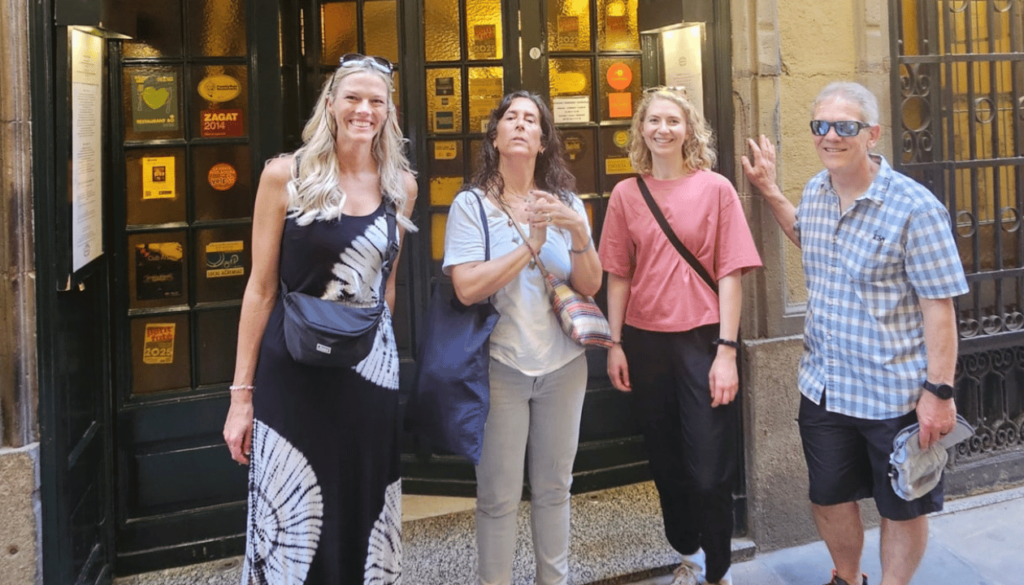
Grammar Meets Culture: Morning Lessons That Travel
Each morning in Dosrius began with a structured but flexible learning session. We worked on verb tenses, starting with the present and moving into reflexive verbs, making connections to her daily routines and habits.
We practiced building basic sentence structures and using adjectives to describe daily routines, ensuring agreement in gender and number for accuracy. Riona would write short descriptions of her day in Spanish to reinforce her learning and expand her vocabulary. Her “cuaderno de cognados” also helped us uncover dozens of Spanish words that felt familiar thanks to her knowledge of English and French.
But this grammar wasn’t confined to the table—it followed us on every walk, into every museum, and even onto the dinner table. Riona would test out new phrases while describing what she was seeing, or during our café conversations in the village. Her learning was fluid, never forced—woven naturally into her day.
Girona: Freedom, Friendship, and Fluency
Midweek, Riona and Karen organised a free day in Girona—a small adventure they planned entirely in Spanish. From buying train tickets to navigating the city, they challenged themselves to stay in the target language. They explored the medieval streets, visited museums, and even enjoyed lunch together, soaking up the language and culture as independent travellers.
Their initiative showed just how far they’d come in just a few days—and how a shared learning journey can create beautiful friendships along the way.

Tapas, Tardeos, and True Conversation
Spanish immersion also means living the language through food and fun. One evening, we headed to Premià de Mar for a “tardeo” with our friends Natalia and Jose—a perfect setting for spontaneous conversation over drinks and seaside views. Laughter filled the air as Riona and Karen asked questions, shared stories, and compared idioms in Spanish.
Later, we enjoyed a tapas dinner at Las Palmeras, where the informal setting encouraged longer, more fluid conversation. These relaxed gatherings provided a fun way to practice Spanish in a real-world environment. It wasn’t just about getting the words right—it was about expressing emotion, responding in real time, and discovering just how much they could say without switching back to English.
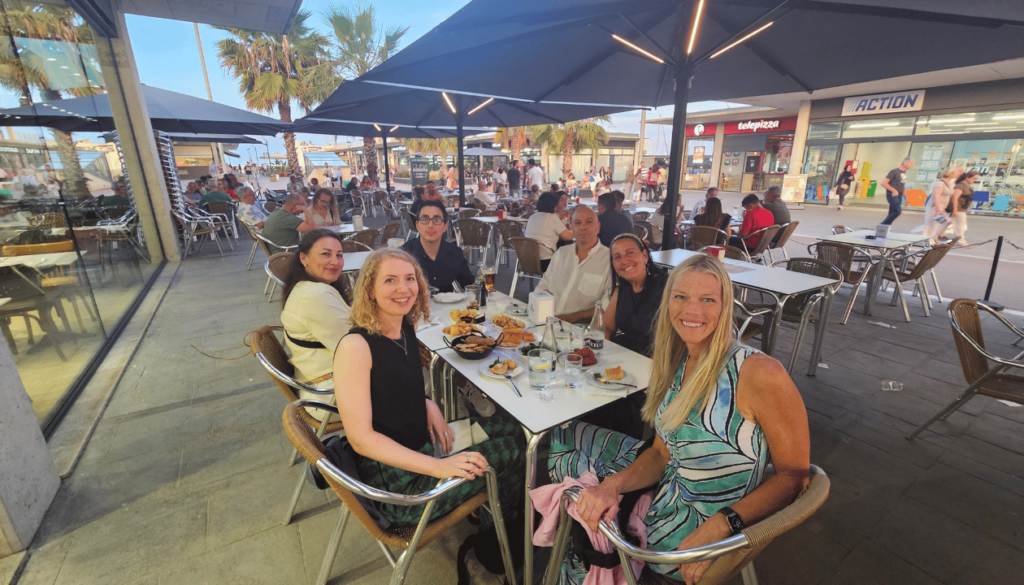
Learning Through Play: Bingo and Beyond
Back at home, not every lesson involved pen and paper. We played verb bingo, which Riona loved—not only because it made her think on her feet, but because it made grammar fun. Laughter and competition turned into learning, and those verbs stuck better than any worksheet ever could.
Exploring Mataró and Poblenou: Two Sides of Catalonia
Together with Karen, Riona joined me on an educational route through Mataró, a coastal city rich in Roman history and modern life. We strolled through local markets, visited historical sites, and ended the day with Argentinian empanadas, chatting all the while about different varieties of Spanish—including Latin American Spanish—and the cultural influences that shape the language.
Later in the week, Riona joined Ana for an immersive walk through Poblenou, a buzzing Barcelona neighbourhood full of street art, innovation hubs, and local cafés. The contrast with quiet Dosrius was striking, but it also added new vocabulary, new experiences, and another side of Catalonia to her immersion story.
Staying Engaged: Keeping the Spark Alive
To keep her motivation high and her learning fresh, Riona made sure to keep things fun and varied. She started playing video games in Spanish, which turned out to be a surprisingly effective way to boost her listening and comprehension skills while picking up new vocabulary in context.
Cooking Spanish recipes became another favorite activity—reading instructions, learning the names of ingredients, and practicing pronunciation as she prepared meals brought language learning into her kitchen in a delicious way.
Riona also challenged herself by watching Spanish TV shows and movies without subtitles, pushing her listening skills and getting used to the rhythm of everyday spoken Spanish. Joining a language learning community gave her a chance to connect with other learners, share tips, and practice speaking and writing in a supportive environment.
By mixing up her activities and staying engaged with the language in different ways, Riona kept the spark alive and continued to make steady progress on her journey to fluency. For her, learning Spanish was never just a task—it was an adventure, full of fun, discovery, and new connections.
Final Reflections
Watching Riona grow in confidence and fluency throughout her week in Dosrius was truly inspiring. She brought her whole self into the experience—curiosity, kindness, and a deep love for learning. Through real-life experiences, Riona learned so much, especially by engaging in conversations, listening to native speakers, and immersing herself in the culture.
Learning a foreign language opened up new perspectives and brought her genuine joy. Her journey is a beautiful reminder that language learning isn’t just about grammar and vocabulary—it’s about connection, culture, and finding joy in the little things. From morning conversations over coffee to spontaneous laughter during our outings, every moment added up to something truly special.
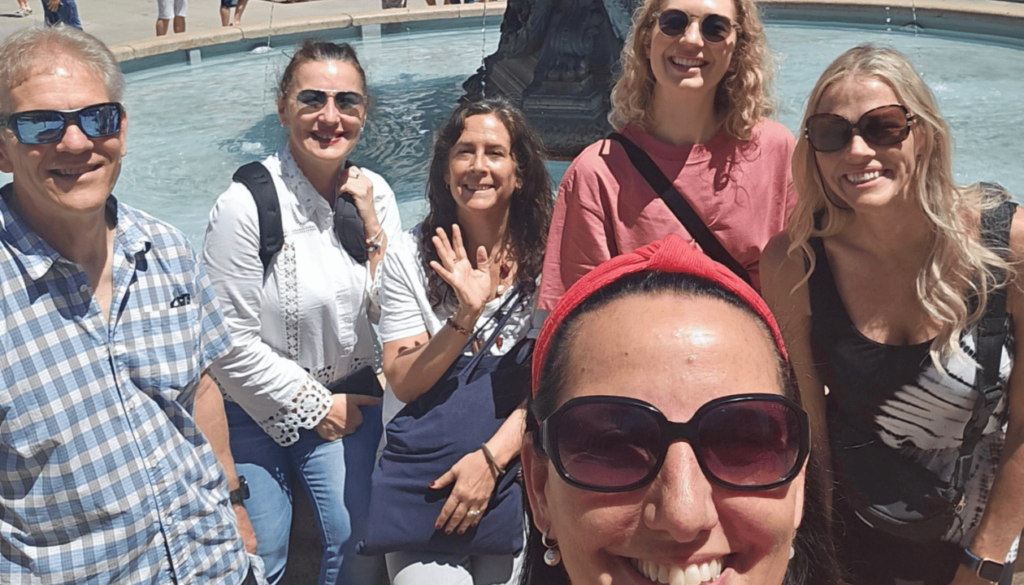
Want to Live and Learn Spanish Like Riona?
If you’re dreaming of speaking Spanish with ease, exploring local culture, and creating unforgettable memories in Spain—just like Riona—our Spanish Homestay Immersion Programme (SHIP) might be exactly what you’re looking for. Live and learn in your teacher’s home, enjoy personalised lessons, and work with a tutor for one-on-one feedback tailored to your needs.
Whether you just started learning Spanish or are looking to improve your fluency, SHIP is suitable for all levels. The program integrates daily activities—like meals, routines, and leisure—into the learning process, making Spanish a natural part of your everyday life and helping you gain confidence in real-world situations.
Ready for your own story? Click here to learn more about SHIP or reach out to us—we’d love to help you plan your Spanish adventure. 🌍✨

